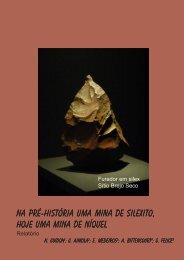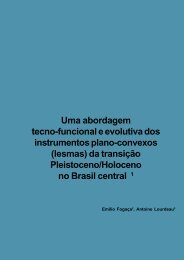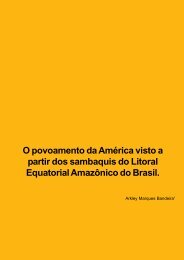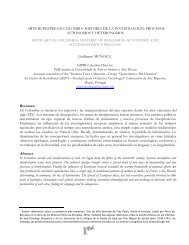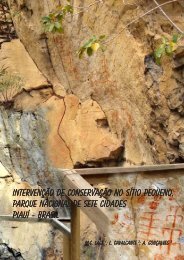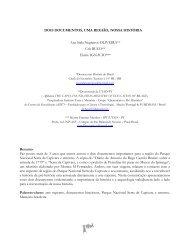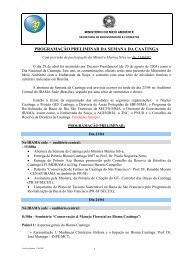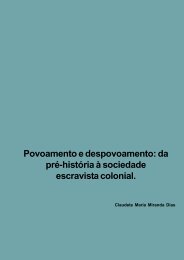Untitled - Fundação Museu do Homem Americano
Untitled - Fundação Museu do Homem Americano
Untitled - Fundação Museu do Homem Americano
You also want an ePaper? Increase the reach of your titles
YUMPU automatically turns print PDFs into web optimized ePapers that Google loves.
Drawing Lions<br />
John Clegg, Austrália<br />
In this paper I apply the suggestion that insights from observing the processes of drawing as they now<br />
happen could help to elucidate ancient rock art. For archaeology, this idea necessarily assumes that similar<br />
aims, capacities and constraints applied then as they <strong>do</strong> now. Other approaches, such as aesthetics or<br />
art history need not make any such assumptions, unless they are applied also to the past. The suggestion<br />
is tried out on two puzzling lion drawings in Grotte Chauvet, presently the oldest authenticated rock art<br />
in Europe, using observations from recent life drawing classes in Australia.<br />
When archaeologists study the past, they often rightly assumed that some characteristics of humans<br />
and their behaviours have remained constant, or that similar needs were met then as they are now.<br />
We eat to satisfy hunger, drink for thirst, shelter against inclement weather, and so on. Recently and<br />
without controversy (Alpert 2009, Watson 2009), it has been assumed that Homo sapiens brains then<br />
were much like our brains now, and that insights from the results of brain-scans into the workings of our<br />
brains are likely to be true for the whole species, at least for brain characteristics which not acquired by<br />
learning, just as we assume that the physical aspects of grinding and flaking stone were similar then as<br />
now. (Some studies of rock art that are not archaeological in nature need not make such assumptions;<br />
aesthetics, for example, may allow us to appreciate aspects of rock art that were not necessarily relevant<br />
to its makers or original consumers.)<br />
Nonetheless, I suggest that fundamentals of both making and seeing drawing and sculpture, – making<br />
representations or designs as well as marks, sculptures as well as harpoons – may also be similar<br />
between then and now. These are assumptions that are usually made, and without controversy, for how<br />
else could one expect to recognise prehistoric pictures as pictures of (depictions, representations) or<br />
even plain pictures or designs? My intention is slightly different: to make these assumptions deliberately,<br />
in the hopes of enhancing the power of archaeology, and on the way potentially testing the assumptions,<br />
which are being used also as hypotheses.<br />
62<br />
(Artigo 56 IFRAO2009)<br />
FUMDHAMentos IX




